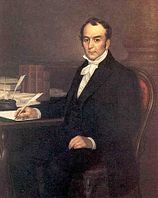U.S. House election, 1820
|
|
||||||||||||||||||||||
|---|---|---|---|---|---|---|---|---|---|---|---|---|---|---|---|---|---|---|---|---|---|---|
|
||||||||||||||||||||||
|
All 187 seats to the United States House of Representatives 94 seats were needed for a majority |
||||||||||||||||||||||
|
||||||||||||||||||||||
|
||||||||||||||||||||||
John W. Taylor
Democratic-Republican
Philip Barbour
Democratic-Republican
Elections to the United States House of Representatives for the 17th Congress took place in the various states took place between July 3, 1820 (Louisiana) and August 10, 1821 (Tennessee). In four states (Illinois, Indiana, Kentucky, Mississippi) the election coincided with the taking of the 4th Census (August 7, 1820). Future enumerations would henceforth be held at a different time of year.
James Monroe won reelection and the Era of Good Feelings, a period of near-complete dominance of national politics by the Democratic-Republican Party, continued after this campaign. However, the Democratic-Republicans lost a small number of seats, due to growing discontent in some urban, eastern areas. However, the huge Democratic-Republican majority remained intact and the Federalist Party started to become increasingly fragmented.
One seat was added during this Congress for the new State of Missouri
On January 24, 1822, Caesar A. Rodney resigned after being elected to the Senate, and was replaced in a special election by Daniel Rodney (F).
Hendricks resigned July 25, 1822 to run for Governor of Indiana. A special election was held to fill the resulting vacancy which elected Jonathan Jennings (DR-J).
Vacancies occurred in the 7th and 8th districts during the 17th Congress. In the 7th district, George Robertson (DR) resigned sometime before the start of the 17th Congress, and was replaced by John S. Smith (DR). In the 8th district, Wingfield Bullock (DR) died October 13, 1821 and was replaced in a special election by James D. Breckinridge (DR)
...
Wikipedia


